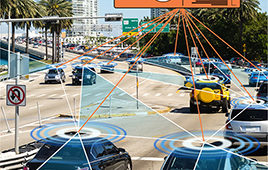Human Running Speeds of 40 mph may be Possible
Jamaican sprinter Usain Bolt’s record-setting performances have unleashed a wave of interest in the ultimate limits to human running speed. A new study offers intriguing insights into the biology and perhaps even the future of human running speed. The newly published evidence identifies the critical variable imposing the biological limit to running speed, and offers an enticing view of how the biological limits might be pushed back beyond the nearly 28 miles per hour speeds achieved by Bolt to speeds of perhaps 35 or even 40 miles per hour.
The new paper, “The biological limits to running speed are imposed from the ground up,” was authored by Peter Weyand of Southern Methodist University; Rosalind Sandell and Danille Prime, both formerly of Rice University; and Matthew Bundle of the University of Wyoming and published in the Journal of Applied Physiology.
“The prevailing view that speed is limited by the force with which the limbs can strike the running surface is an eminently reasonable one,” said Weyand, associate professor of applied physiology and biomechanics at SMU in Dallas.
“If one considers that elite sprinters can apply peak forces of 800 to 1,000 pounds with a single limb during each sprinting step, it’s easy to believe that runners are probably operating at or near the force limits of their muscles and limbs,” he said. “However, our new data clearly show that this is not the case. Despite how large the running forces can be, we found that the limbs are capable of applying much greater ground forces than those present during top-speed forward running.”
In contrast to a force limit, what the researchers found was that the critical biological limit is imposed by time — specifically, the very brief periods of time available to apply force to the ground while sprinting. In elite sprinters, foot-ground contact times are less than one-tenth of one second, and peak ground forces occur within less than one-twentieth of one second of the first instant of foot-ground contact.
The researchers took advantage of several experimental tools to arrive at the new conclusions. They used a high-speed treadmill capable of attaining speeds greater than 40 miles per hour and of acquiring precise measurements of the forces applied to the surface with each footfall. They also had subjects’ perform at high speeds in different gaits. In addition to completing traditional top-speed forward running tests, subjects hopped on one leg and ran backward to their fastest possible speeds on the treadmill.
The unconventional tests were strategically selected to test the prevailing beliefs about mechanical factors that limit human running speeds — specifically, the idea that the speed limit is imposed by how forcefully a runner’s limbs can strike the ground.
However, the researchers found that the ground forces applied while hopping on one leg at top speed exceeded those applied during top-speed forward running by 30 percent or more, and that the forces generated by the active muscles within the limb were roughly 1.5 to 2 times greater in the one-legged hopping gait.
The time limit conclusion was supported by the agreement of the minimum foot-ground contact times observed during top-speed backward and forward running. Although top backward versus forward speeds were substantially slower, as expected, the minimum periods of foot-ground contact at top backward and forward speeds were essentially identical.
According to Matthew Bundle, an assistant professor of biomechanics at the University of Wyoming, “The very close agreement in the briefest periods of foot-ground contact at top speed in these two very different gaits points to a biological limit on how quickly the active muscle fibers can generate the forces necessary to get the runner back up off the ground during each step.”
The researchers said the new work shows that running speed limits are set by the contractile speed limits of the muscle fibers themselves, with fiber contractile speeds setting the limit on how quickly the runner’s limb can apply force to the running surface.
“Our simple projections indicate that muscle contractile speeds that would allow for maximal or near-maximal forces would permit running speeds of 35 to 40 miles per hour and conceivably faster,” Bundle said.
Peter Weyand is an associate professor of applied physiology and biomechanics in SMU’s Annette Caldwell Simmons School of Education & Human Development. Matthew Bundle is an assistant professor of biomechanics in the College of Health Sciences at the University of Wyoming.




